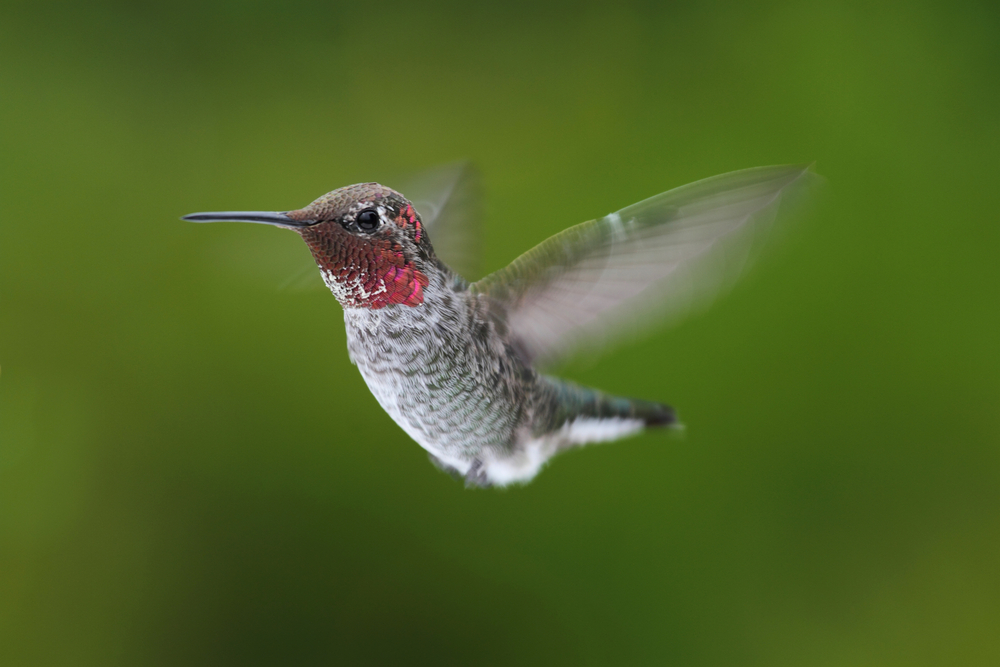A hummingbird is a delight to behold in your garden. The tiny visitor zooms into your yard in the blink of an eye. Its skills of hovering and maneuvering can be observed as it quickly jets from flower to flower. Then, as quickly as it came, the visitor is gone.
Gardeners love attracting hummingbirds to their gardens. If you are a gardener or bird enthusiast in Maryland, you may be wondering what types of hummingbirds you might observe. If you are looking for hummingbirds in Maryland, you are sure to find them. You will likely see the common Ruby-throated Hummingbird, but you just might get lucky and see one of Maryland’s less common hummingbird visitors.
Species of Maryland Hummingbirds
Although only one species of hummingbird nests in Maryland, that does not mean that only one type of hummingbird is possible to observe in Maryland. Several other species have been observed in Maryland, some with frequency and some very rare, bringing the total species of Maryland Hummingbirds up to six. These are the six species of hummingbirds that have been recorded in Maryland.
- Ruby-Throated Hummingbird – Archilochus colubris
- Rufous Hummingbird – Selasphorus rufus
- Black-Chinned Hummingbird – Archilochus alexandri
- Allen’s Hummingbird – Selasphorus sasin
- Calliope Hummingbird – Selasphorus calliope
- Anna’s Hummingbird – Calypte anna
Ruby-Throated Hummingbird – Archilochus colubris

Coloration and Markings: both male and female Ruby-throated Hummingbirds are a dazzling emerald or golden-green color on their back and crown with gray/white underparts. Males have an iridescent red throat, which gives the species its name. In some lighting, the male’s throat may appear black.
Size: This small hummingbird weighs between .1 and .2 ounces. The Ruby-Throated Hummingbird is between 2.8 and 3.5 inches in length. It has a wingspan of 3.1 to 4.3 inches.
Habitat: The Ruby-Throated Hummingbird can be found in clearings near the edge of a forest, open woods, and city parks. They frequent gardens where flowers and hummingbird feeders are present.
Diet: The Ruby-Throated Hummingbird feeds mainly on nectar and small insects. It favors tubular flowers but will also drink from hummingbird feeders filled with sugar water.
More about the Ruby-Throated Hummingbird
The Ruby-Throated Hummingbird is the most common in the eastern United States. It is the only species of hummingbird that nests in Maryland and can be seen throughout the state from April or May through September.
The Ruby-Throated Hummingbird migrates to Central America for the winter, many flying over the Gulf of Mexico in one flight.
Rufous Hummingbird – Selasphorus rufus
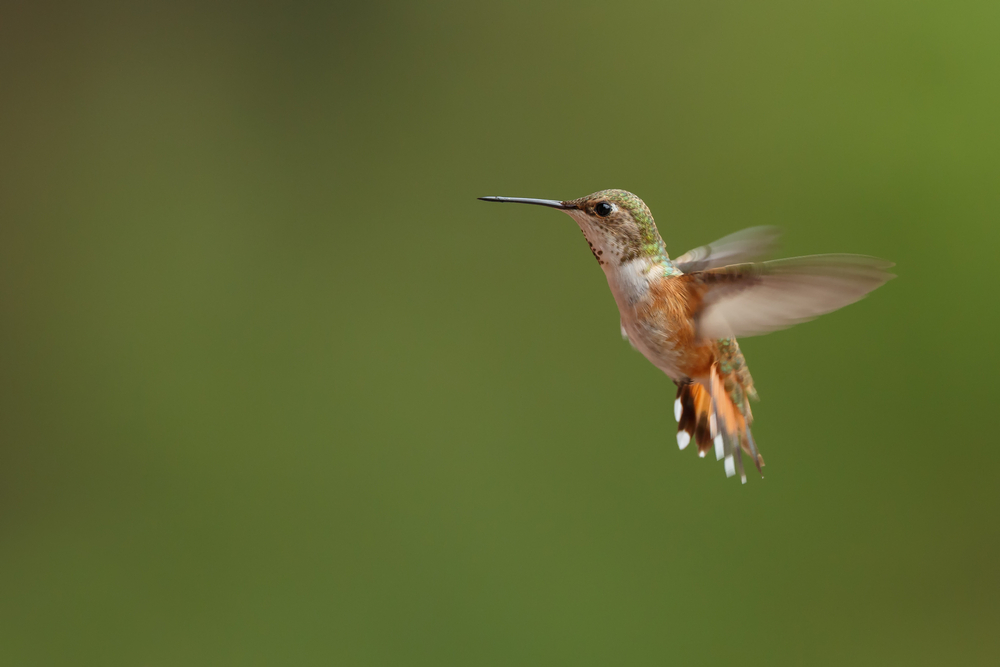
Coloration and Markings: The male Rufous Hummingbird is bright coppery orange on the back and belly with a white patch on its upper breast and an orange/red throat. The female is green above with rufous-washed flanks and a green tail with rufous patches. Females often have an orange spot on the throat.
Size: The Rufous Humminbird weighs between .1 and .2 ounces. It is between 2.8 and 3.5 inches long and has a wingspan of about 4.3 inches.
Habitat: Rufous Hummingbirds prefer open areas like yards, parks, forest edges, and mountain meadows. In the Fall and Winter, birdwatchers are more likely to observe the Rufous Hummingbird in higher elevations.
Diet: Rufus Hummingbirds prefer the nectar of red tubular flowers like red columbines, paintbrush, penstemons, scarlet sage, gilia, and others. In addition to nectar, Rufous Hummingbirds will eat small insects. It will drink sugar water provided in hummingbird feeders.
More about the Rufous Hummingbird
The Rufous Hummingbird is very uncommon in Maryland, but it tends to be seen at least once a year, typically in the late Fall or Winter. It is the most common Westen Hummingbird to be observed in the East.
Don’t let its tiny size fool you–the Rufous Hummingbird is known to attack other hummingbirds, some up to twice its size, when competing for flowers.
The Rufous Hummingbird makes one of the longest migratory journeys of all birds in relation to its body length. Some Rufous Hummingbirds fly from Alaska to Mexico, 3,900 miles (or 78,470,000 body lengths) in each direction.
Black-Chinned Hummingbird – Archilochus alexandri
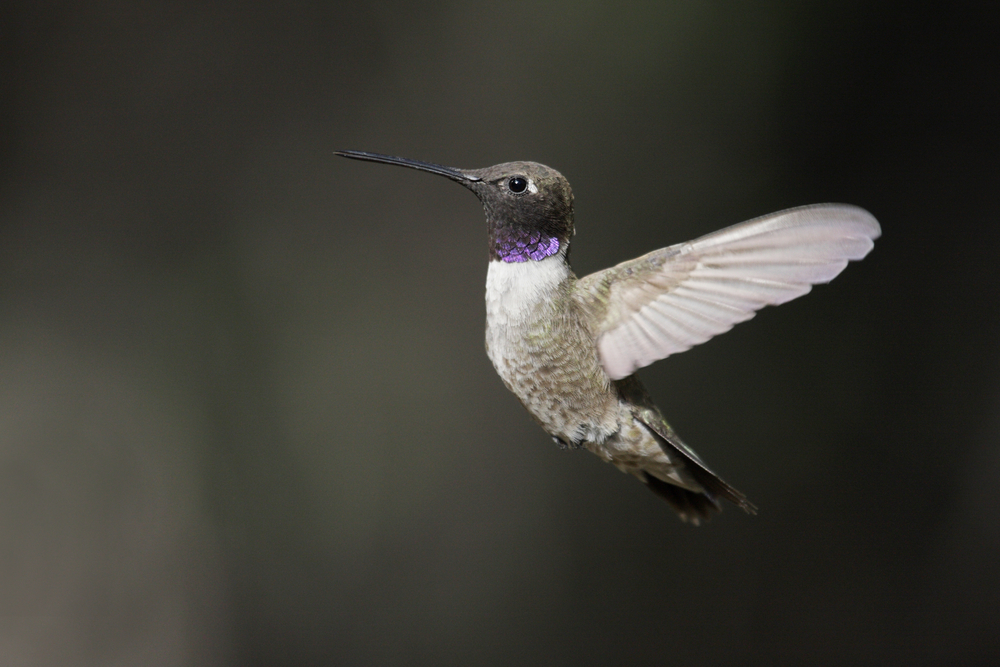
Coloration and Markings: Both male and female Black-Chinned Hummingbirds are a dull metallic green above and white/gray underneath. Males have a black throat with a thin strip of iridescent purple. Females have a pale throat and white on the tips of their outer tail feathers.
Size: The Black-Chinned Hummingbird weighs between .1 and .2 ounces. It is about 3.5 inches in length and has a wingspan of about 4.3 inches.
Habitat: The Black-Chinned Hummingbirds will inhabit almost any environment with flowers and tall trees like streamsides, oak groves, and parks. It is one of the most adaptable hummingbird species and can even live in urban areas.
Diet: The Black-Chinned Hummingbird has a diet of nectar and small insects. It will also drink sugar water from hummingbird feeders.
More about the Black-Chinned Hummingbird
Although they are a Western species, Bird watchers have sighted Black-Chinned Hummingbirds in most states along the East Coast, including several sightings in Maryland in recent years in the Fall and Winter.
The Black-Chinned Hummingbird loves to perch on bare branches in high trees. If they pass through Maryland during migration, they are unlikely to stay at the same feeder for more than one day.
Calliope Hummingbird – Selasphorus calliope
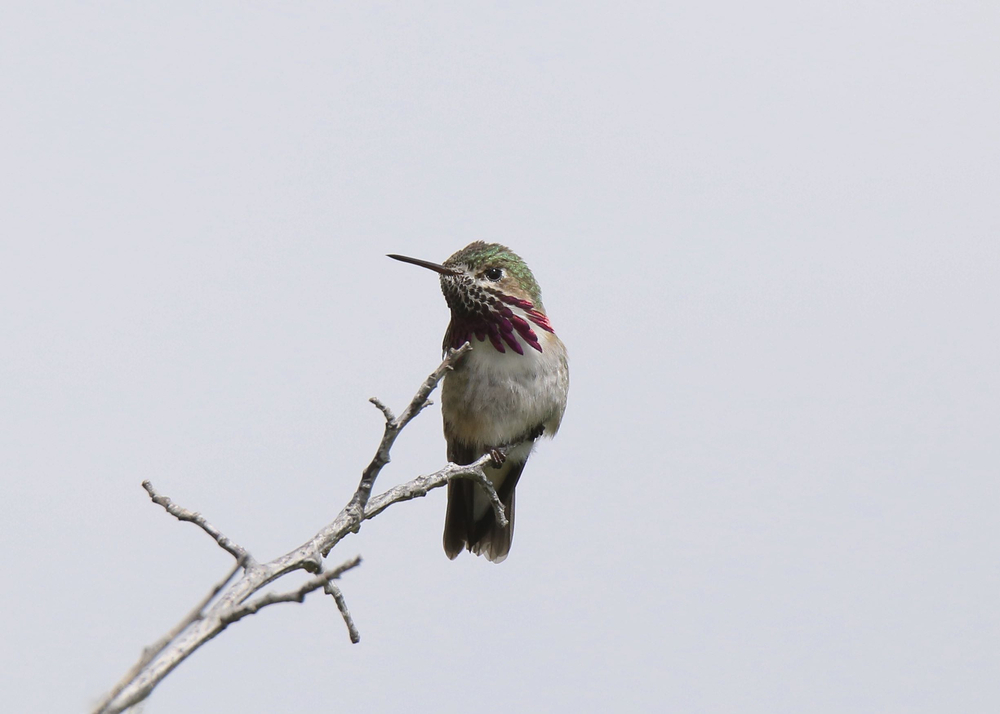
Coloration and Markings: Both the male and female Calliope Hummingbird are greenish above. Birdwatchers can recognize the male by the magenta stripes on his throat. The male has a greenish vest, while the female has a peachy tint across the underparts.
Size: The Calliope Hummingbird weighs about .1 ounces. It is 3.1 to 3.5 inches long. The Calliope Hummingbird has a wingspan of 4.1 to 4.3 inches.
Habitat: The Calliope Hummingbird inhabits open, shrubby areas like forest glades, canyons, mountains, and near streams.
Diet: The Calliope Hummingbird feeds on nectar and small insects. It will also drink from hummingbird feeders filled with sugar water.
More about the Calliope Hummingbird
The Calliope Hummingbird is rare on the East Coast. However, in recent years it has been spotted in Maryland several times. The Calliope is most likely to be seen in the late Fall and Winter in cold locations along the bay like Chesapeake Beach and Cape St. Claire.
The Calliope is the smallest bird in the United States. It may be overlooked in gardens because it tends to feed at low flowers to avoid larger hummingbirds.
Anna’s Hummingbird – Calypte anna
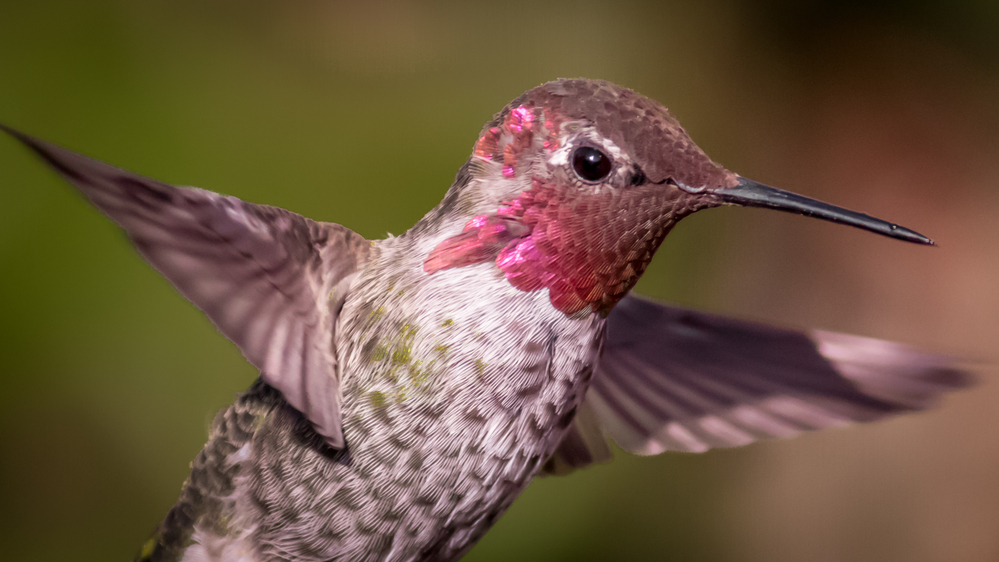
Coloration and Markings: Both male and female Anna’s Hummingbirds are green and gray. The male has a reddish-pink head and throat, although they can look brown or gray without direct sunlight.
Size: Anna’s Hummingbird weighs between .1 and .2 ounces. It is about 3.9 inches long and has a wingspan of about 4.7 inches.
Habitat: Anna’s Hummingbirds have a wide variety of habitats, including open woodlands, streamside groves, and mountain meadows. Anna’s Hummingbirds often inhabit yards, parks, and residential areas.
Diet: Anna’s Hummingbirds feed on nectar and tiny insects. They will also visit hummingbird feeders filled with sugar water.
More about the Anna’s Hummingbird
With only a few recorded sightings, Anna’s Hummingbird is one of the rarest Maryland hummingbirds.
Anna’s Hummingbird fascinated early Europeans. Christopher Columbus wrote about them and wondered if the tiny, iridescent creature was a cross between an insect and a bird.
Allen’s Hummingbird – Selasphorus sasin

Coloration and Markings: Allen’s Hummingbird is very similar in coloring to the Rufous Hummingbird. Males have a coppery tail, eye patch, and belly. They have a bronze-green back and a deep reddish-orange throat patch. Female and immature Allen’s Hummingbirds are bronze-green above with paler coppery sides. Both males and females have bronze spots on the throat. Females tend to have more throat spots and a reddish-orange patch on the center of the throat.
Size: The Allen’s Hummingbird weighs about .1 ounces. It is about 3.5 inches long and has a wingspan of about 4.3 inches.
Habitat: The Allen’s Hummingbird prefers semi-open habitats such as oak woods, streamside groves, wooded suburbs, and city parks.
Diet: The Allen’s Hummingbird favors the nectar red tubular flowers such as paintbrush, scarlet sage, red monkey-flower, red columbine, and penstemon. In addition to nectar, this small bird will eat tiny insects and drink sugar water from hummingbird feeders.
More about the Allen’s Hummingbird
The Allen’s Hummingbird is extremely rare in Maryland. The first recorded sighting in Maryland occurred in 2008, and birdwatchers have seen it at least twice since.
The Allen’s Hummingbird and the Rufous Hummingbird are closely related. Females and immature Allen’s Hummingbirds are nearly impossible to distinguish from the Rufous without close observation.
Conclusion
We hope you enjoyed learning about the different types of Maryland hummingbirds. If you want to see hummingbirds, they are likely to visit your garden if you plant hummingbird-friendly flowers or hang a hummingbird feeder filled with sugar and water.
Ruby-throated Hummingbirds will likely visit your garden throughout the Spring and Summer, but do not take the feeder down when the Ruby-throated leaves in the Fall. Leave your hummingbird feeder up throughout the Fall and even into the Winter, and you will have a better chance of spotting one of the more rare Maryland hummingbirds.
